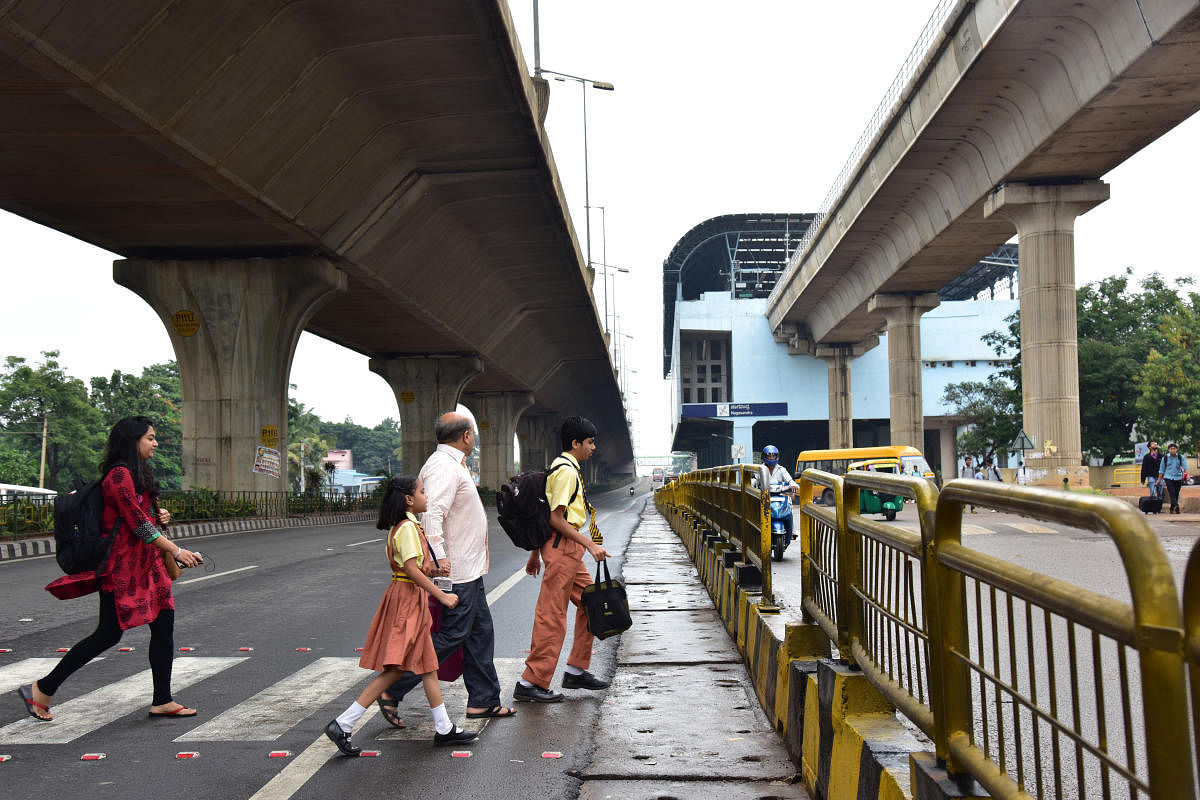Packed like sardines in a peak-hour rush, do Namma Metro commuters fancy another train ride even if it means an escape from those chaotic roads? Getting off the green line, should they risk their dear lives crossing the Tumakuru Road as the Metro had no foresight to build underpasses?
Out there on the Metro platforms, as thousands of commuters await their turn, these hard questions have come to the fore like never before. The promised six-coach train is yet to arrive, and tenders to build two subways on Tumakuru Road have been cancelled. To make matters tougher, the Sunday morning rush at Majestic continues to grow since the holiday service starts only at 8 am.
Crossing woes
Tumakuru Road is a critical arterial link to the city. Despite the elevated section taking a big load, the traffic is extremely high on the road below. Building pedestrian subways to help Metro commuters cross over was a no-brainer. Yet, the planners chose to ignore this critical gap.
People have paid with their lives. One of them was Pooja, a teenager who had alighted from the Nagasandra Metro Station to head to her house. She was crossing the highway when a speeding vehicle fatally knocked her down. There was no way she could pass that road safely. There was no subway and no traffic constable to help her.
But it took many more lives for the Bangalore Metro Rail Corporation Limited (BMRCL) to even think about safe access. The 2.5-km line between Peenya and Nagasandra was opened in May 2015, but tenders for the subways were invited only in September 2017.
Cancelled tenders
These tenders have now been cancelled. Reason: Bidder quoted an exorbitant amount. If subways were part of the original design, the cost would have been much lower. Two years ago, DH had highlighted the glaring gap and the lives endangered by the design flaw.
A reality check by DH showed just how tough it is to cross Tumakuru Road at Nagasandra. Hundreds of commuters could be seen walking over 500m to find a safe way across. It gets only tougher during peak hours and when it rains. School children, workers from a nearby factory and residents of an apartment complex on the other side of the Metro line are all among the struggling walkers.
Risky walkers
At the Dasarahalli Station, commuters are forced to walk almost a kilometre to reach the Hesarghatta Cross Junction. This hyper-congested intersection offers no respite to the pedestrians. They have to jostle for space with hundreds of factory workers and the flood of vehicles heading towards Hesarghatta and other areas. A subway here is a must, say both commuters and motorists.
But there are six more stations on the green line along Tumakuru Road that are in dire need of solutions to cross the busy highway. At the Peenya station, for instance, accidents have already killed two Metro commuters. People, young and old, often hurry past the road to get across to the industrial area and a dental hospital on the other side.
The crossing is tricky and extremely hazardous here as vehicles from the Outer Ring Road (ORR) head towards the elevated section of the highway at high speeds. At the Tumakuru Road – ORR Junction, the heavy traffic worsens the chaos.
Planning gaps
Why were these not factored in at the Metro’s Detailed Project Report (DPR) stage itself? “BMRCL could have planned for these subways when the National Highways Authority of India (NHAI) was building the elevated corridor. BMRCL, which spends thousands of crores exclusively on mass transport, is not bothered about integration,” notes urban mobility analyst Sanjeev Dyamannavar.
Indeed, BMRCL had received permission from NHAI to use the land next to the highway for subway construction. But why was this process delayed?
Six-car trains
Even as this question remains unanswered, another query bothers commuters: When will the six-car train chug in? The first of these trains is now undergoing tests. The new intermediate cars are being added to the midsection of the existing three-car trains to conduct a series of tests at static and running status within the depot.
BMRCL assures that these trains will be on the tracks sometime in June, after the go-ahead by the Commissioner of Railway Safety (CRS). The current three-car train can carry 975 people. A six-car train doubles that capacity, potentially decongesting services during rush-hour. The big plan is to convert all the trains on both green and purple lines to six-car services by June 2019.
Stuck in long queues at the Majestic interchange station, commuters await these trains in despair. For, the peak-hour rush could only get worse once new lines are added and the existing lines are extended under the second phase.
This comment from a frustrated commuter should tell the story: “During peak-hours, I end up watching the long queue fill up at least three trains before my turn comes.”
